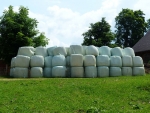
It is impossible to produce quality silage from poor quality pasture, no matter how good the fermentation is. Both the quality of the ensiled pasture and the quality of the fermentation must be considered. These can be measured by having a feed analysis done on your silage.
With well preserved silage, losses in feeding value during fermentation will be small, and the final silage will be only slightly lower in feeding value than the original pasture.
The quality of the fermentation tells us how well the quality of the original pasture has been preserved in the silage:
pH: The lactic acid produced during fermentation causes a decrease in pH. A low pH will prevent an unwanted butyric fermentation, which reduces the feeding value and palatibility of the silage. Low DM silage needs a lower pH than high DM silage.
Ammonia-N: Low values for ammonia-N indicate minimal breakdown of protein in the silage, usually because pH has fallen quickly to a low level in the silage.
Lactic and butyric acids: High concentrations of lactic acid are seen in well preserved silage. High levels of butyric acid are found in poorly preserved silage, and indicate that an unwanted butyric fermentation has occurred.
Assessing by sight, smell
If you don't have a feed analysis for your silage you can estimate quality from its appearance.
Feed quality: High quality silage contains lots of leaf and very little stem. The more stem in silage the poorer its quality.
Colour: Well-preserved silages are green, yellow or pale brown. Dark brown silage is generally poorly preserved. Smell: Well preserved silage has a sweet, tobacco smell. Foul, rancid smells indicate the presence of butyric acid from poor preservation.
Moulds: These grow where silage has been exposed to air. Some fungi can produce toxins.
Quality silage can support high milk production. In England, 560kg Friesian cows have eaten 16kg DM/day as pasture silage (approx 11 MJ ME/kg DM, 7% Ammonia-N) and produced 1.6kgMS/day for 14 weeks without losing body condition.
When silage is fed to cows as a sole diet, intake is generally lower than that of fresh pasture. Increasing the ammonia-N from 5% to 10% can result in a 5-10% drop in DM intake. A 5% decrease in digestibility (from 70% to 65%) can cause a 2kgDM/day drop in DM intake. Feeds of lower digestibility provide the cow with less nutrients for milk production. A 5% drop in silage digestibility for a 200 tonne silage stack (50 tonne DM) could result in 300kg less milksolids produced, and 450kg liveweight loss, if fed to milking cows. Low quality silage (made from low quality pasture, or ensiled with low quality fermentation, or both) will not support high milk yields. In fact many silages made on dairy farms in New Zealand are only suitable for maintaining cows.
- silage
- DairyNZ
- losses
- feeding
- feed